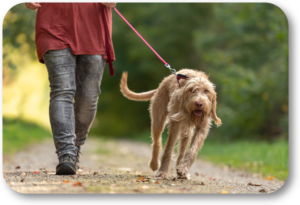I was in Suwanee last Monday working with a new Home Dog Training client and his two-year-old Dutch Shepherd named Marshal. Marshal was a relatively well-behaved dog. He quickly understood that he was not the leader of the family and that he should obey and pay attention to our clients. We quickly resolved many of his annoying behavioral quirks such as his jumping on guests, barking at anything in the back yard, stealing food off their dinner plates, and rushing the front door every time someone rang the doorbell. We also worked on improving his basic obedience commands such as Come, Sit, and Stay.

We concluded the session by walking inside the house and he was very attentive and stayed next to my client. My client thought that all of this was wonderful but had one more issue that needed to be addressed. One big problem that Marshal had was when they were walking in the neighborhood.
Our client stated that Marshal walks great most of the time, but sometimes he gets distracted and just goes nuts. He starts jumping, charging, standing on his two back paws, and barking. Our client was wondering, besides all the great dog training techniques we already taught him, if there was something for this issue…
First of all, I responded with a very resounding “Yes”.
Robin and I have often encountered this walking problem with dogs that are a little overactive and aren’t clearly attentive to their owners. It is important to master the normal “walk next to me” exercises to get the walking on the right foot, but this problem requires that our client takes the walking activity to the next level.
We told our client not to worry because the “next step” does not mean that he is necessarily going to use choke chains, chock collars, or anything that would frighten his dog. What our client needs to do is to actively enforce the rule of “pay attention to me” while they are walking. Once this is accomplished, his dog is submitting that our client will take charge of any “strange distraction” they could encounter, and it is not his dog’s responsibility to do all those annoying and embarrassing actions.
I suggested the following dog training process:
- It is important to pick the “right collar” for the walk. When my client needs to direct his dog with the leash, his dog should experience a correction of a quick tug/snap. This gives a clear “learning moment” where a regular “pull back with all your might” sensation can often mistakenly be taken as the beginning of a “tug of war” game by the dog. When I stated “right collar”, I didn’t mean a simple dog collar. Robin and I always strongly encourage our clients to use an Easy Walk Harness in conjunction with a standard collar when walking their dog. This will not hurt the dog and will constantly redirect the dog back to them.
- We instruct our client to allow his dog to have a little more leash than normal as they go out for a walk.
- As soon as the dog begins to walk in front of our client or his gaze begins to wander from our client or the path directly in front of him, he needs to give the leash a quick tug (it might take several of these actions) until the dog returns to his side and is focusing on our client.
- If the dog continues to walk ahead of our client, ne needs to stop walking and allow the dog to continue walking until he reaches the “end of the leash”. Just as he reaches the end, our client should give the leash a firm tug/snap for his dog to look back and see that he is far away and in front of our client. Our client should now change direction and walk in the opposite direction.
- While walking, he should stop several times and just have his dog stop and command him to sit next to him.
- They should continue to change directions while walking. He should give the leash a quick tug/snap as soon as his dog is not attentively changing direction with him.
We always instruct our clients not to commence this process during “busy times” in their neighborhood. The important goal of this exercise is to enforce the dog’s need to constantly “check in with our client”. We suggest starting off when it is quiet so that our client can constantly provide his dog with the proper instruction. Ramp up the exercise by walking at progressively active times.
I recently concluded this training program with a very large Rhodesian Ridgeback that wanted to go after neighbors and their animals while on a walk. After a few sessions using these techniques, the dog was perfect.
Please call Robin or me at (770) 718-7704 if you need any dog training help. We are blessed to have been your local dog training professionals for over seventeen years. We have trained over 5,000 great dogs and loving families and are ready to help you.

Follow Us!